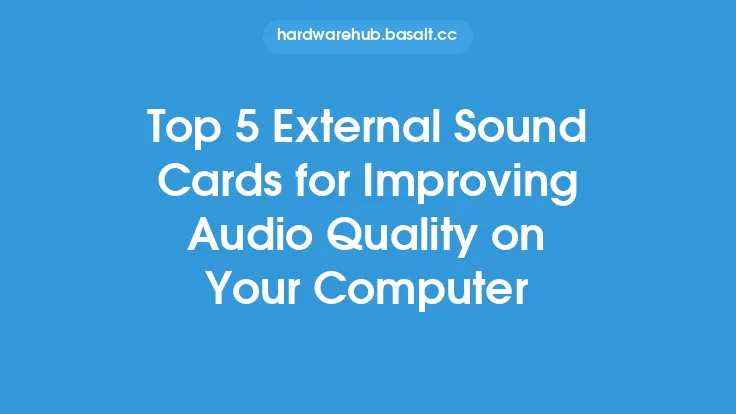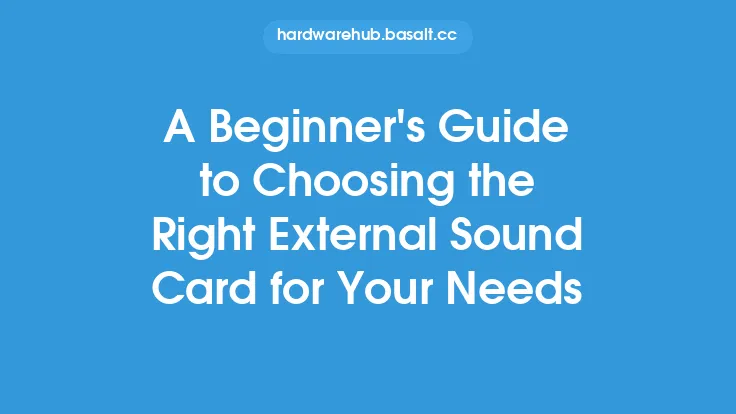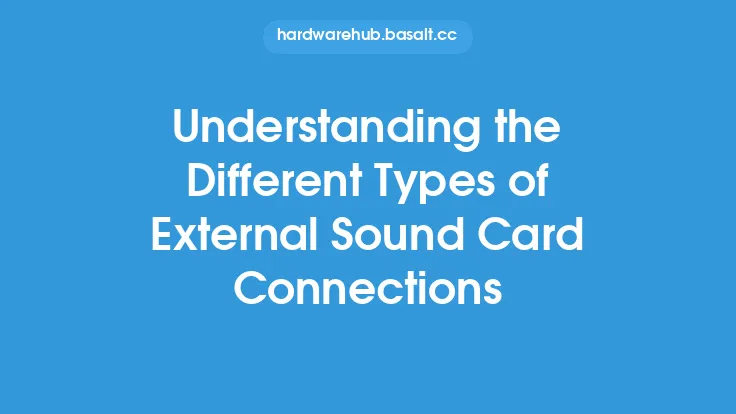When it comes to home recording and podcasting, having high-quality audio is essential for producing professional-sounding content. One of the key components in achieving this is an external sound card. An external sound card is a device that connects to your computer and provides a dedicated audio interface, allowing you to record and play back audio with greater fidelity and control. In this article, we'll explore the best external sound cards for home recording and podcasting, and what features to look for when choosing the right one for your needs.
Key Features to Consider
When selecting an external sound card for home recording and podcasting, there are several key features to consider. First and foremost, you'll want to look at the device's audio resolution and sampling rate. A higher resolution and sampling rate will result in better sound quality, with 24-bit or 32-bit resolution and a sampling rate of at least 44.1 kHz being a good starting point. You'll also want to consider the number and type of audio inputs and outputs, as well as the device's connectivity options, such as USB, Thunderbolt, or PCIe.
Another important feature to consider is the device's preamp quality, as this will have a significant impact on the sound quality of your recordings. Look for a device with high-quality preamps that can provide a clean and quiet signal, and consider a device with adjustable gain controls to allow for optimal signal levels. Additionally, consider the device's compatibility with your computer and recording software, as well as its durability and build quality.
Popular External Sound Cards for Home Recording and Podcasting
There are many external sound cards on the market that are well-suited for home recording and podcasting. Some popular options include the Focusrite Scarlett series, the PreSonus AudioBox series, and the Native Instruments Komplete Audio 1. These devices offer a range of features and price points, from entry-level models with basic functionality to high-end models with advanced features and high-quality components.
The Focusrite Scarlett series, for example, offers a range of devices with up to 18 audio inputs and outputs, as well as high-quality preamps and a durable metal construction. The PreSonus AudioBox series, on the other hand, offers a range of devices with up to 8 audio inputs and outputs, as well as high-quality preamps and a compact, rugged design. The Native Instruments Komplete Audio 1, meanwhile, offers a range of advanced features, including high-quality preamps, a built-in headphone amplifier, and a compact, bus-powered design.
Advanced Features to Consider
In addition to the basic features mentioned earlier, some external sound cards offer advanced features that can be useful for home recording and podcasting. These may include built-in effects processing, such as reverb or compression, as well as advanced routing and monitoring options. Some devices may also offer MIDI connectivity, allowing you to connect and control external MIDI devices, such as synthesizers or drum machines.
Other advanced features to consider include the device's clocking and synchronization options, as well as its compatibility with external clock sources. This can be important if you're working with multiple devices or need to synchronize your audio with video or other media. Additionally, consider the device's power requirements and whether it can be bus-powered or requires an external power source.
Connectivity and Compatibility
When choosing an external sound card, it's also important to consider its connectivity and compatibility with your computer and recording software. Most external sound cards connect to your computer via USB, but some may also offer Thunderbolt or PCIe connectivity. Consider the speed and bandwidth of the connection, as well as the device's compatibility with your computer's operating system and recording software.
In terms of compatibility, look for devices that are compatible with popular recording software, such as Pro Tools, Logic Pro, or Ableton Live. You'll also want to consider the device's drivers and software support, as well as its compatibility with any external devices or equipment you may be using. Additionally, consider the device's warranty and support options, as well as its reputation and user reviews.
Conclusion
In conclusion, choosing the right external sound card for home recording and podcasting can be a complex and overwhelming process, but by considering the key features and advanced options mentioned in this article, you can find a device that meets your needs and helps you produce high-quality audio. Whether you're just starting out or are a seasoned professional, an external sound card can be a valuable addition to your recording setup, providing a dedicated audio interface and a range of features and options to help you achieve professional-sounding results. By doing your research and choosing a device that's right for you, you can take your recordings to the next level and produce audio that sounds great and is free from noise and distortion.





